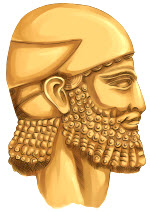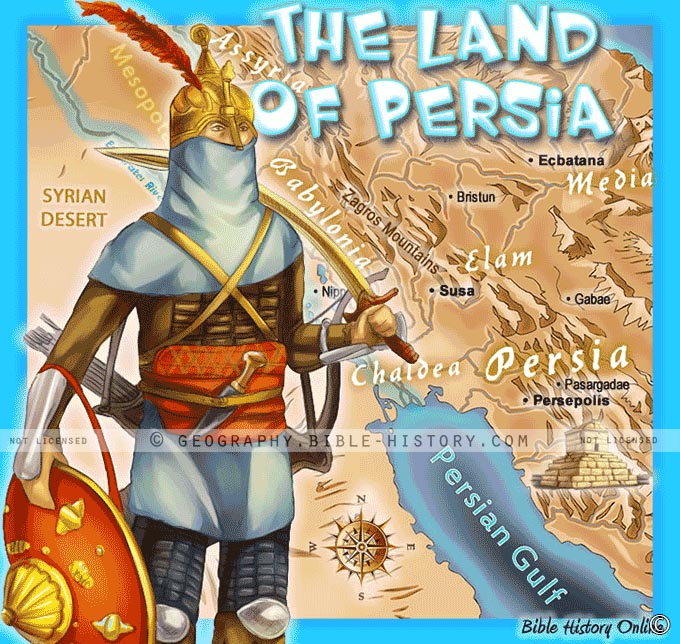The Land of Persia
This map is available as a high resolution digital download with detailed instructions. You must bring the file to an Office Depot or similar store for easy color print and lamination. For personal, church or classroom use only.
Ezra 1:2-3 "Thus says Cyrus king of Persia: All the kingdoms of the earth the LORD God of heaven has given me. And He has commanded me to build Him a house at Jerusalem which is in Judah. Who is among you of all His people? May his God be with him, and let him go up to Jerusalem which is in Judah, and build the house of the LORD God of Israel (He is God), which is in Jerusalem."
FOLLOW THE MAP
The Land of Persia for Little Kids

This map shows the land of Persia which became one of the largest empires of the ancient world. God's prophets predicted that Persia would defeat Babylon in one day and become the next world empire. These prophesies were fulfilled when the Babylonian king, Belshazzar, was having a feast and a big party. He was defiantly drinking from the gold and silver cups that were stolen from the Temple in Jerusalem, when all of the sudden the king of Babylon noticed that a hand was writing on the wall.
The only person who could read the writing was the Israelite Daniel, and he told Belshazzar that the writing said that Babylon was going to fall and be divided between the Medes and Persians. That night, the Persians and Medes conquered Babylon!
Soon after, the Persian king Cyrus generously freed the Jews that were captured by Babylon and allowed them to return to Israel and rebuild their Temple!
Persia was also the kingdom where Esther became queen and
saved all of the Jews. God knew exactly what would happen when He gave Persia
power, and because of that, Persia played a very important role in biblical
history!
The Land of Persia for Big Kids
 Persia
in Bible History. God, who controls history, raised up the Persians to be a
powerful and yet benevolent kingdom. At the perfect time a king named Cyrus
would come to power and generously allow the Jews to return to their land and
rebuild their Temple and the city of Jerusalem. The Persians descended from
Shem's oldest son Elam who migrated to the area southwest of the Caspian Sea.
When the Jews were taken into captivity by Babylon, Cyrus the Persian conquered
Babylon and also the rest of the world. He set up a wise administration allowing
various nations to maintain their cultures and their religions as long as they
submitted to Persian authority. It was at this time that Cyrus made a decree
allowing the Jews to return to their homeland and to rebuild their Temple. The
famous decree is recorded on the Cyrus Cylinder which was excavated by
archaeologists. This event was also important because in Daniels prophecy he
predicted that 483 years from that decree to restore and rebuild Jerusalem the
Messiah would die in Israel. This amazing prophecy was fulfilled by Jesus
Christ. The story of Esther is also important in Biblical history because God
foreknew that one of the Persian rulers (Haman) would try to annihilate the Jews
and he worked a miracle through a Jewish Queen named Esther who risked her life
by exposing this plot to Xerxes, King of the Persian Empire. This event is still
celebrated by the Jews in the traditional Feast of Purim.
Persia
in Bible History. God, who controls history, raised up the Persians to be a
powerful and yet benevolent kingdom. At the perfect time a king named Cyrus
would come to power and generously allow the Jews to return to their land and
rebuild their Temple and the city of Jerusalem. The Persians descended from
Shem's oldest son Elam who migrated to the area southwest of the Caspian Sea.
When the Jews were taken into captivity by Babylon, Cyrus the Persian conquered
Babylon and also the rest of the world. He set up a wise administration allowing
various nations to maintain their cultures and their religions as long as they
submitted to Persian authority. It was at this time that Cyrus made a decree
allowing the Jews to return to their homeland and to rebuild their Temple. The
famous decree is recorded on the Cyrus Cylinder which was excavated by
archaeologists. This event was also important because in Daniels prophecy he
predicted that 483 years from that decree to restore and rebuild Jerusalem the
Messiah would die in Israel. This amazing prophecy was fulfilled by Jesus
Christ. The story of Esther is also important in Biblical history because God
foreknew that one of the Persian rulers (Haman) would try to annihilate the Jews
and he worked a miracle through a Jewish Queen named Esther who risked her life
by exposing this plot to Xerxes, King of the Persian Empire. This event is still
celebrated by the Jews in the traditional Feast of Purim.
The Land of Persia. The Persians descended from Elam, the oldest son of Shem and grandson of Noah. The area of ancient Persia was very large, its boundaries were Media and the Great Desert in the north, Assyria, Babylonia, and Chaldea on the west, The Persian Gulf on the south, and a large desert on the east before the Indus River. Persia had very rugged mountains and also deserts and fertile valleys. The Araxes River flowed from the mountains near the Persian Gulf upward through the territory. Ancient Media was originally part of Persia and the people of ancient Persia were fearless in battle, and eventually they conquered all the surrounding areas. Persia was famous throughout history for their export of flawless grapes, and roses, and silk and many other beautiful things. The mountains around Persia were famous for having the healthiest air and the brightest skies.
Susa. Susa was the ancient capital of the Elamite Empire. It was a very fertile region located about 150 miles north of the Lower Sea (Persian Gulf) near the base of the Zagros Mountains. Susa was one of royal cities during the Persian Empire.
Persepolis. Persepolis was another royal city of the Persian Empire. It was located about 300 miles southeast of Susa. It was here that King Darius I moved his capital to when he ascended the throne in 522 B.C. He built a splendid palace at Persepolis on a forty foot high stone platform. It is interesting that out of the 72 columns 13 are still standing.
Pasargadae. Pasargadae was located forty miles northeast of Persepolis and was the first capital of the Persian Empire founded by Cyrus the Great. It was here that he built his beautiful gardens and his magnificent palace. At the southwest border, in the ruins of the city, lies the tomb Cyrus.
Ecbatana. Ecbatana became the capital city of the Medes in the late seventh century B.C. Ecbatana is actually the Greek name of the city mentioned in the book of Ezra "Achmetha" (Ezra 6:2). It was located around 180 miles southwest of Tehran, the capital of modern Iran. It was in the Zagros Mountains, about 6000 feet above sea level, on a caravan route that ran for Mesopotamia to the Persian plateau. Cyrus the Great, the Persian ruler, enjoyed the weather here during summer months, and he made it his summer capital.
The Persian Empire. The Persian Empire became the largest empire the world had ever known at the time. It became a world empire during the reign of Cyrus the Great to the reign of Darius I, which was roughly 550-486 BC. The prophets in the Bible predicted that Babylon would fall in one day by the Medes and Persians and there would be a new world empire after Babylon, the Medo-Persian Empire. Its boundaries extended from the Aegean Sea in the west to the Indus River in the east, such a large empire was created in just a little over 10 years by Cyrus II the Great.
King Cyrus the Great. Cyrus II, also known as Cyrus the Great was the founder of the Persian Empire. He was of the Achaemenid family and the vast Achaemenid Empire of the Persians reached from the Aegean Sea in the West all the way to Sagdiana in the East. It encompassed the former kingdom whom it had conquered, the Babylonian Empire. The Bible mentions in the book of Ezra that King Cyrus issued a decree from the Persian Palace at Achmetha (Ecbatana) to free the Jews, and allow them to return to Israel to rebuild their Temple in Jerusalem. There have been archaeological discoveries confirming this decree and event.
Daniel's Prophecy. It is interesting that the prophet Daniel predicted that in 483 years from the decree of Cyrus to release the Jews to rebuild their temple the Messiah would be "cut off" indicating the death of Jesus on the cross.
King Xerxes. King Nebuchadnezzar was the most powerful ruler to come out of Babylon. He waged war against any country who would not submit to his authority. According to the Bible he built a statue of gold, which symbolized that his kingdom would never pass away. Later he learned who was the true King.
King Darius I. King Nebuchadnezzar was the most powerful ruler to come out of Babylon. He waged war against any country who would not submit to his authority. According to the Bible he built a statue of gold, which symbolized that his kingdom would never pass away. Later he learned who was the true King.
The Destruction of Babylon. In 586 BC the Babylonians came and conquered Jerusalem and destroyed the beautiful Temple of Solomon.
The Release of the Jews. The Babylonians took the Jewish prisoners over to the land of Babylon where they were made captives for 70 years. The Jews were prisoners in the land of idolatry.
Ancient Persian Religion. The ancient Persians believed in many gods, and these gods were associated with nature, warfare, daily life, and concepts like good and bad, and truth and justice. Around 600 BC a man named Zoroaster arose teaching great ethical truths. He revolutionized the ancient religion and taught men to do good, to speak the truth, and to abhor the lie. He taught dualism, that there was an internal conflict between the truth (Arta) and the lie (Druj). many accepted these beliefs, but there was also a large number who held to the ancient traditions. Eventually the Zoroastrianism prevailed with much of it modified. The ancient ruins at Persepolis and other Persian cities reflect their religious beliefs.
The Fall of Babylon. In 539 BC the Persian king Cyrus "the great" redirected the Euphrates River and marches armies in and conquered Babylon. The Bible records the Babylonian and the Persian rulers that existed during the time of Daniel, who was one of the Jewish captives.
The study of ancient Persia is very important in the study of the Bible, let's pray:
Dear Jesus, we thank you for your word which declares that you are not a God who is far away but you are near to your people. You declared that if the Jews rebelled they would be punished, and yet later they would return to their homeland. You promised he would raise up a generous leader and even named him as Cyrus through the prophet Isaiah, and he allowed the Jews to come home and rebuild their temple. This is indeed a miracle, thank you God that your promises are anchored within the veil and you remain true. We love you and we praise you. In Jesus name? Amen!
![]()
The Land of Persia for Little Kids

Map of the Land of Persia for Bible Study
Kid's Bible Maps
Bible
History Online
The Geography of the Bible
© Bible History Online (https://bible-history.com)
Made by Network Local